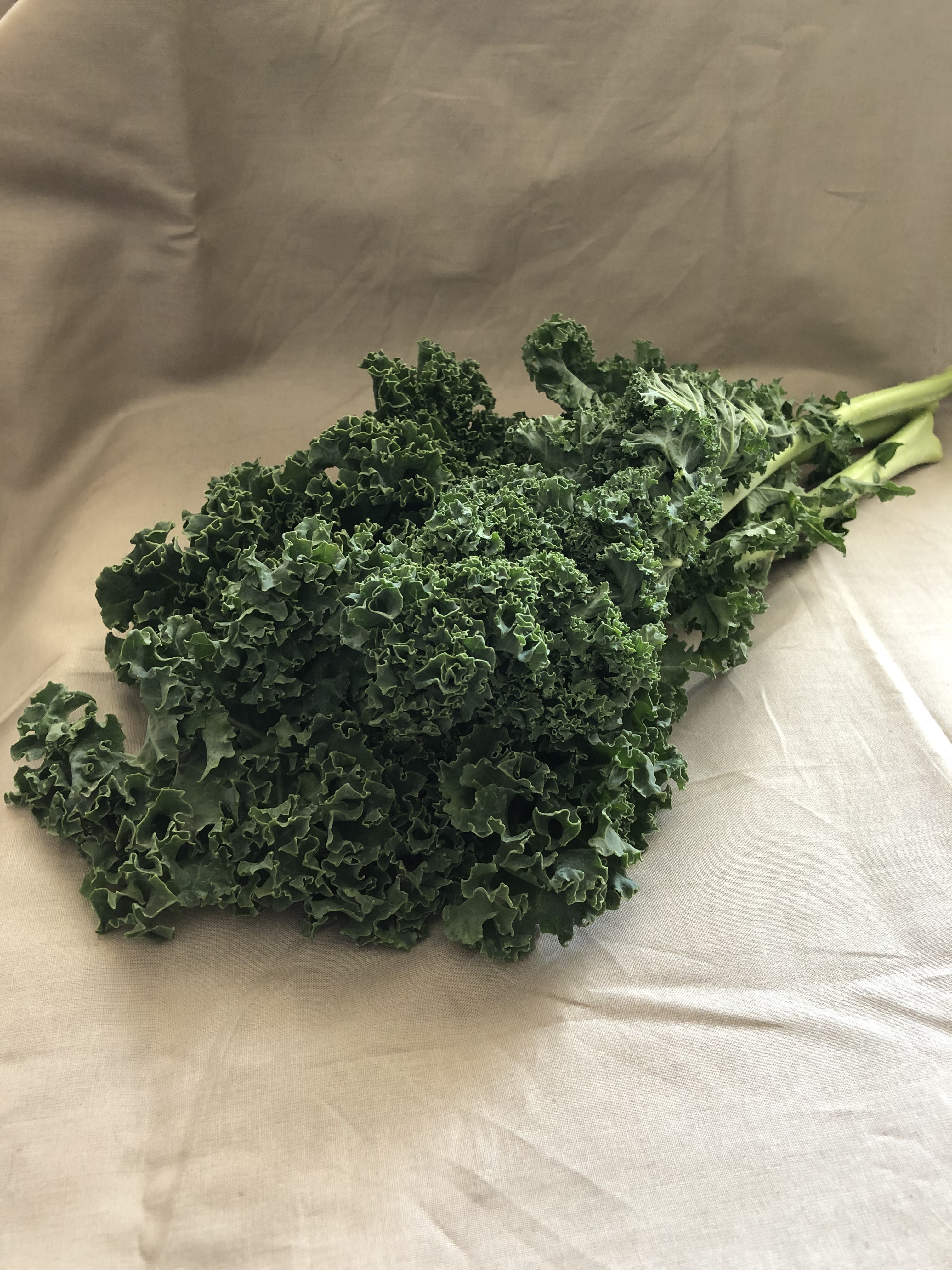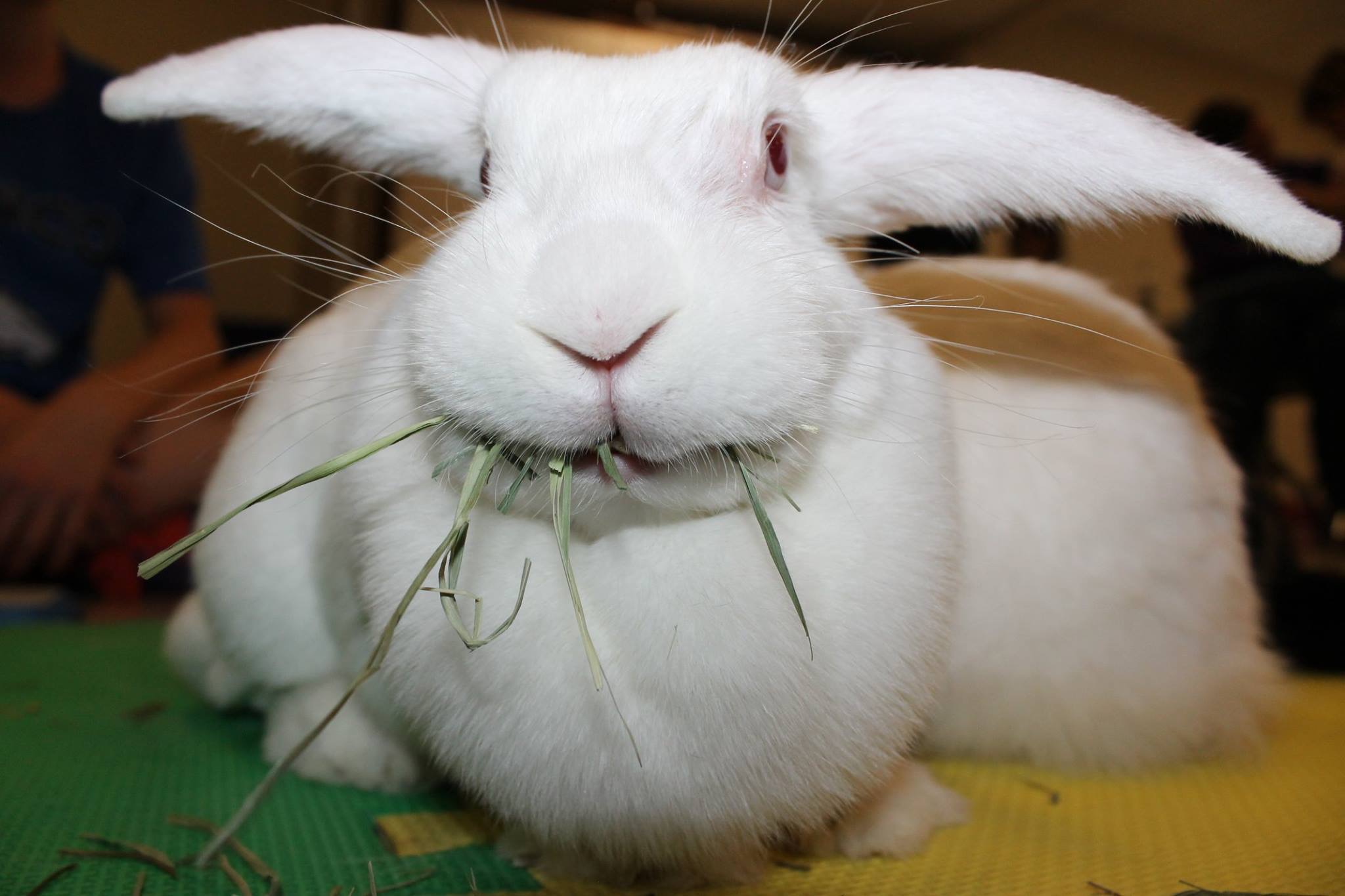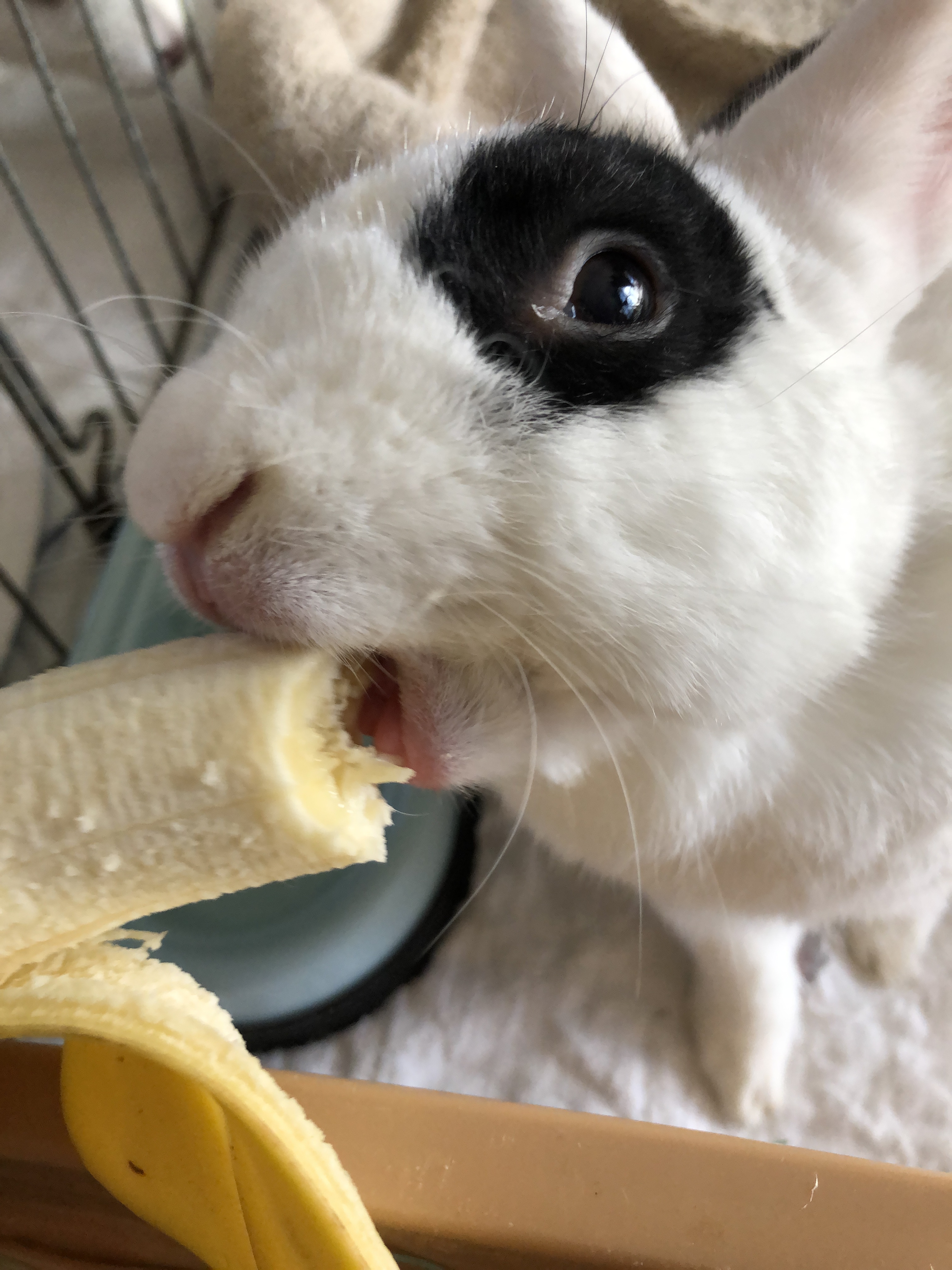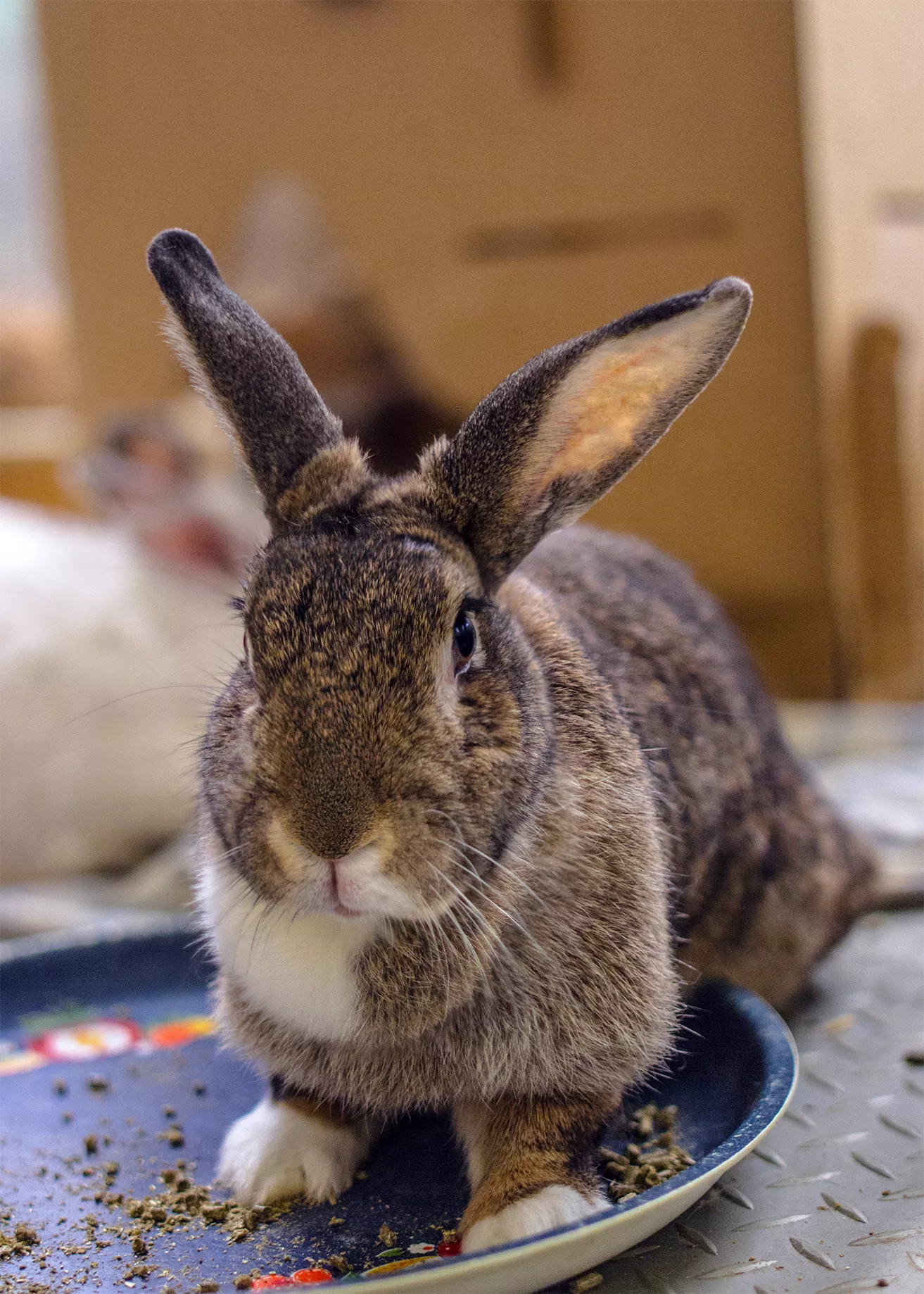- Home
- Rabbit Diet
- Vegetables for Rabbits
Vegetables for Rabbits
 Petra with her dill pillow
Petra with her dill pillowHow Much Is Too Much?
Appropriate portions and type of vegetables for rabbits is a topic that can cause confusion for rabbit owners.
About 15-20% of the diet should be vegetables (fruits will be discussed under TREATS). Generally speaking, suitable greens for every day feeding is lettuce (any kind EXCEPT iceberg - no nutrients) and herbs, which includes parsley, cilantro, dill, basil, etc. The amount is approximately 2 cups of veggies per 6lbs of rabbit (this can be split into two feedings).
 Proper Veggie Serving Size for one rabbit fed greens once a day. The serving consists of green leaf lettuce, Italian parsley, mint and dill.
Proper Veggie Serving Size for one rabbit fed greens once a day. The serving consists of green leaf lettuce, Italian parsley, mint and dill. Diamond always loved his parsley!
Diamond always loved his parsley!There are great debates in the rabbit community as to which vegetables are suitable for bunnies or which are appropriate only in moderation (or not at all). These discussions usually revolve around the oxalic acid levels, sugar, calcium, fiber or other nutrient content in plants. Reputable sources have suggested vegetables such as spinach, broccoli, cabbage, brussel sprouts, bell peppers and zucchini are good to feed out either in rotation or in small amounts.
Personally, I have recommended that owners should stay away from broccoli, cabbage, cauliflower and brussel sprouts. Studies have shown that these types of foods can be higher in starch (which is more problematic than gas when it comes to a rabbit's digestion). They can be fed out, but in limited quantities.
Spinach is high in calcium and can contribute to sludge in the bladder. Bell peppers and zucchini are OK, but in all my years with rabbits, I have only heard of one rabbit who liked to eat bell peppers. I think they are not fond of the waxy skin of these vegetables, but that is my theory. If you happen to run out of your normal supply of bunny veggies, and all you have is spring mix with baby spinach and broccoli florets in your fridge, go ahead and feed it out. Your rabbit will not expire eating the occasional spinach leaf or broccoli stem.
 Whoppy
WhoppyIn my first couple of years with rabbits, I experimented with a variety of different vegetables (sometimes not the best choices as I later found out, but seeing Whoppy and Oso covered head to toe in purple beet juice was quite the sight to see. They looked like they had just come from a set of a horror movie). I fed out quite a bit of celery, parsley, red leaf lettuce and tomatoes. Usually, tomatoes I just sliced up in the hottest days of summer to help keep the bunnies hydrated, since tomatoes seem to have a great deal of water content. If you are going to feed out celery, do make sure it is chopped well. The danger is that the “strings” can get tangled in the intestines and cause an obstruction.
Now I feed my bunnies a mix of lettuces (usually romaine, red or green leaf and/or endive). Occasionally some fancy 'artisan' lettuces (when I'm feeling fancy and rich) and herbs (always parsley, with dill, mint and/or basil as other usual staples for my buns). Each bunny has their favorite herb or lettuce which I try to accommodate. I will feed out at least 3 different types a day.
Important: Any list you use may still need to be adjusted to a particular rabbit. Some bunnies have a sensitive gut and can tolerate only a few vegetables. Others could mow down the entire produce section in the grocery store with no ill effect. Still, there are those that are picky eaters and will only eat one or two different types at best.
 Most bunnies adore Kale, but it can cause some digestive problems, namely an excessive amount of soft poop.
Most bunnies adore Kale, but it can cause some digestive problems, namely an excessive amount of soft poop.As a groomer, I saw many rabbits with clumps of soft poop stuck on the butt. This was not diarrhea (rabbits rarely have diarrhea, but when they do, the poop is not just soft, but is extremely watery). Most often this was a diet situation. The first question I always asked was, “What is the diet?” Usually the problem was too many treats, pellets, really rich vegetables or a combination of all of the above. In terms of veggies, the culprits tend to be a daily serving of kale, dandelion greens, Swiss chard or carrot tops. Unfortunately, kale is a big hit with rabbits. However, if bunny butt smeared with smelly poop is a regular problem, I would recommend cutting down on those type of vegetables to once or twice a week (or just for a special occasion).
Bunny Approved!
This list of acceptable foods are all that I have given to my bunnies. They include the following:
- Lettuce (Romaine, Red or Green Leaf, Escarole, Endive, Radicchio, etc. Rabbits do like the bitter varieties.)
- Arugula
- Wheatgrass
- Watercress
- Baby Bok Choy
- Fennel (tops and base)
- Basil
- Mint
- Dill
- Cilantro
- Oregano
- Thyme
- Rosemary (mine aren't crazy about it)
- Parsley (curly and Italian)
Important: Some sources will recommend to limit parsley due to the high oxalic acid content. Parsley has always been a main part of my bunnies’ diet, with no ill effects.
The following foods should be only fed out 1-2 times a week. These veggies tend be richer, and can create a fair number of very soft stools.
- Kale
- Carrot and Beet tops
- Swiss Chard
- Dandelion Greens
Foods to Avoid
 Do not let your young bunnies experiment with the dog or cat food. Note, Oso and Whoppy were only allowed to hang around long enough for me to take this picture. Around this age, I had to make sure the dog dishes were out of reach before I could let them out. Otherwise they would jump in the bowl and start eating the kibble. This phase did not last long, and they both outgrew this experimental stage in a few weeks.
Do not let your young bunnies experiment with the dog or cat food. Note, Oso and Whoppy were only allowed to hang around long enough for me to take this picture. Around this age, I had to make sure the dog dishes were out of reach before I could let them out. Otherwise they would jump in the bowl and start eating the kibble. This phase did not last long, and they both outgrew this experimental stage in a few weeks.Stay away from onions, garlic, leeks, chives and any other plants in the onion family of plants. Corn is another food you want to stay away from, as the kernels can cause bowel obstruction. Bowel obstructions lead to bloat, which is an emergency that can cause death if not treated quickly.
Do NOT feed out chocolate, cookies, crackers, bread, cake, muffins, chips, popcorn, yogurt, honey, pasta, candy or any other foods that are processed. Do not let your bunny snack out of the dog or cat food bowl, and do not give your bunny bird seed or meat (yes, I have either seen or have been asked all of those things at one time or another). Sometimes very young bunnies (about 3-4 months old) will try the dog food kibble. Make sure you put that out of reach when you let the babies out of the pen to play.
Tips! When you have a large number of rabbits living with you, becoming a bargain grocery shopper is critical. Visit Farmer Markets or speak to the Produce Manager at your local grocer. I would caution about just randomly "getting a box of discarded veggies" from the produce department. Many times these will be veggies you can't feed to your bunnies anyways. Make sure the person knows what you are looking for. Also check out smaller, local markets or supermarkets catering to a more international clientele. Sometimes they have better bargains.
Further Reading
Harcourt-Brown, Frances. 2002. Textbook of Rabbit Medicine. Oxford: Butterworth Heinemann
Moore, Lucile. 2011. Rabbit Nutrition and Nutritional Healing. College Station: Virtualbookworm.com Publishing Inc.




